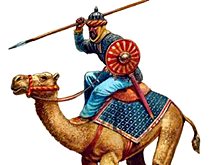
Battle of Mount Bourgaon |
year: 535Summer 535 |
| A Byzantine victory against Moorish rebels | ★ ★ ★ ★ ★ |
|
enemy: Berbers
|
location: In the unidentified Mount Bourgaon in central Tunisia, probably in Kairouan Governorate
|
accuracy:
●●●●●
|
|
battle type: Mountain Battle |
war: Berber Tribes Rebellions |
modern country:
Tunisia |
| ▼ The Byzantines(emperor: Justinian I) | ▼ The Enemies | |
| Commander: | Solomon (Carthage governor) | Esdilasas, Iourphouthes, Mesidinissas |
| Forces: | < 18,000 | > 50,000 |
| Losses: | 0 | 50,000 (!?) |
| Background story: |
| Following the departure of general Belisarius from Carthage after the destruction of the Vandal kingdom in 534, the local population of Berbers revolted. Solomon (Σολόμων), the praetorian prefect (governor of the province) gathered an army of 18,000 and defeated them in the battle of Mammes. As soon as Solomon returned to Carthage, he received a report that the Moors had come back into Byzacium (central-eastern Tunisia) plundering everything there. He therefore turned back immediately and went against them with his whole army. |
The Battle: |
 Berber warrior The Moors however had no intention to leave their secure position and to fight the Romans in level country, especially after their recent crushing defeat at Mammes. The Berbers made their camp at the middle of a slope that was relatively easy to be accessed having in mind that an elevated position had an adequate advantage and also that if needed they could move to higher ground fast. But they made a mistake and left undefended the slopes of the mountain that were more difficult to be accessed believing that the enemy would never dare to try an attack from those sides. When Solomon realized that the Berbers had no intention to fight on level ground and seeing his troops in distress at the prospect of making a prolonged siege in the desert, he decided to take the initiative. He ordered Theodoros, commander of the excubitores to lead a unit of 1000 men to the east side of the mountain which was extremely difficult to ascent and for this reason was not guarded by the enemy. Theodoros managed to reach the unprotected peak of the mountain, behind and above the enemy camp during the night. At early dawn, Solomon with the rest of the army moved against the position of the Moors on the mountain. At the same time, the soldiers of Theodoros displayed the Roman standards and started their attack. The Moors turned all of them in a hasty flight. As they could not run up to the top or go down to the plain they ran towards other peaks through narrow passages trying to cross a vale between the peaks . But because they were too many of them, their panic created great confusion and disorder as those coming from behind were pushing off the cliffs those at the front. Some managed to escape only when the vale was filled with dead bodies (of men and horses) and were able to pass across stepping over them. Procopius reports that over 50,000 Moors were killed (perhaps an exaggeration). The Romans had no losses at all. No one was even wounded! From the enemy leaders only Esdilasas was captured. The remaining chieftains remembered an oracle that their nation would be destroyed by a beardless man. So they had a good excuse to sew for peace. |
Noteworthy: |
| The women and children whom the Romans seized as booty were so many that the slave market in Carthage collapsed so that a Moorish boy would be sold to a price of a sheep. |
Aftermath: |
| Solomon then set about erecting forts along the borders and the main roads, hoping to contain the raids of the Moors. But the region was always under attack. Solomon ws killed 10 years later in Cillium. |
|
|
